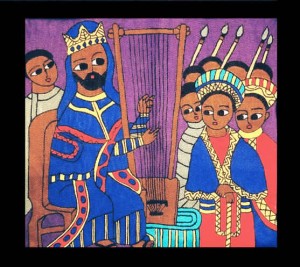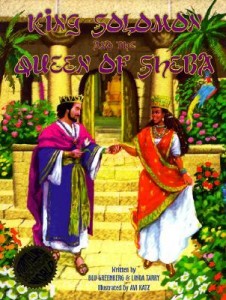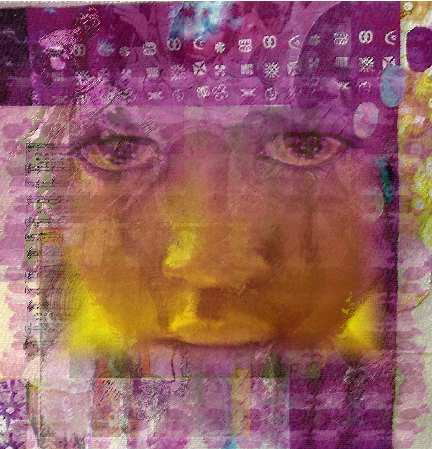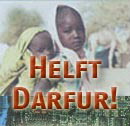Posts Tagged ‘africa’
Exchange Between Groups Took Place About 2,000 Years Ago
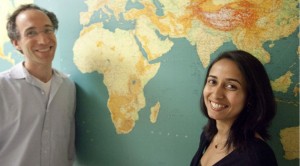 Genetic Melting Pot: David Reich (left) and Priya Moorjani found that Jews and Africans mixed genes about 2,000 years ago. (Kris Snibbe/Harvard Staff Photographer)
Genetic Melting Pot: David Reich (left) and Priya Moorjani found that Jews and Africans mixed genes about 2,000 years ago. (Kris Snibbe/Harvard Staff Photographer)
In the Book of Kings, Solomon is depicted as an international businessman of sorts who sent ships from the port of Etzion-Geber, near modern day Eilat, to trade precious metals and other goods with various parts of the world, including Africa. Solomon also famously received a visit from the Queen of Sheba, who is thought to be from what is presently Ethiopia.
Now, a new scientific paper offers a genetic timeline that could support these biblical tales. The paper builds on two studies published last summer that were the first to use genome-wide analyses to trace the history of the Jewish people through DNA.
“It demonstrated that there was a biological basis for Jewishness,” said Dr. Harry Ostrer, director of the human genetics program at the New York University School of Medicine, who led one of the studies.
Among its many findings, Ostrer’s paper indicated that Jews have African ancestry — an observation that David Reich, associate professor of genetics at Harvard Medical School, and his colleagues decided to explore further.
Reich’s team analyzed more than half a million DNA markers across the entire genomes of people from seven diverse Jewish populations — including Ashkenazim from northern Europe; Sephardim from Italy, Turkey and Greece, and Mizrahim from Syria, Iraq and Iran. They then compared the genetic data with DNA from 15 sub-Saharan African populations.
Reporting in the April issue of PLoS Genetics, the researchers found that modern day Jews can attribute about 3% to 5% of their ancestry to sub-Saharan Africans, and that the exchange of genes between Jews and sub-Saharan Africans occurred approximately 72 generations, or about 2,000 years, ago.
Priya Moorjani, a doctoral student in Reich’s lab who led the research, was surprised that the degree of African DNA was so consistent across the various Jewish populations. She had expected, for example, that North African and Middle Eastern Jews would have a greater degree of genetic mingling than Europeans, based on their geographic proximities.
So the findings, Moorjani said, may point to a shared ancestry among the various Jewish groups. “It’s definitely suggestive that most Jewish populations have a common ancestral population,” she said.
Although the Harvard team couldn’t determine where exactly the exchange of genes took place, the results complement historians’ understanding of the Jewish narrative.
“This is interesting, and it gives me food for thought,” said Norman Stillman, a professor of Judaic history at the University of Oklahoma. “Does it prove something historically specific beyond the fact that we know the Jewish bloodline was open to some extent throughout history? No. But it fits in with the rest.”
Lawrence Schiffman, a professor of Hebrew and Judaic studies at Yeshiva University, said two time periods came to mind that could support the geneticists’ findings. The first is during the First Temple Period, between about 950 B.C.E. and 600 B.C.E., when Solomon’s kingdom would have had contact with Africans.
Or, Schiffman said, the mixing of populations could have taken place a bit later, during the Hellenistic period, from about 320 B.C.E. to 30 B.C.E., when Jews were living all over the southern shore of the Mediterranean Sea and could have come into contact with Africans to the south of them.
Yet even though the biblical accounts offer possible explanations for the Reich lab’s findings, Schiffman stresses that he and other social scientists can only offer historical interpretations of the genetic data. “The facts are the ones that scientists are developing; the theories are what [historians] have,” he said. “We now have to take what they are giving us, and we have to add it to our picture of history.”
Stillman pointed out that Jews are often thought of as an insular group, because they tended to marry within their community. “But,” he said, “that doesn’t mean there wasn’t, all throughout history, an inflow of others into the group.”
As Reich sees it, genetics and history are not actually so disparate. His work, he said, is “a kind of complementary way of studying history.” Contact Gianna Palmer at palmer@forward.com, Originally posted HERE
The Bible-Solomon (Ben Cross, Vivica Fox)
King Solomon Embroidery
The North American Ethiopian Conference on Ethiopian Jewry (NACOEJ) Embroidery Program
King Solomon and The Queen of Sheba
by Blu Greenberg, Linda Tarry, and Avi Katz (Illustrator)
Publication: Simcha Media Group, 1997
Ages 4-8
Darfur Solidarity Fast
Monday and Tuesday, June 15 and 16, I’ll be part of an international
“fasting chain,” going without food for two consecutive days in solidarity with
the people of Darfur.
Fast in solidarity with the hungry and starving in Darfur and for lasting peace in Sudan!
3 Ugandan Teens Learn Leadership Skills on L.A. Trip

From left, Kokasi Keki, 17; Sarah Nabagala, 17; and Igaal Sizomu, 15, at Shomrei Torah Synagogue in West Hills. Photo by Jason Lipeles
Igaal Sizomu was clearly ecstatic, laughing with a group of friends from Shomrei Torah Synagogue (STS) whom he hadn’t seen in nearly a year. They were pushing each other around at the West Hills synagogue the way teens often do.
Igaal, who is from Uganda, had spent five years adjusting to life in Southern California while his father, Rabbi Gershom Sizomu, was interning at Shomrei Torah Synagogue and attending American Jewish University’s Ziegler School of Rabbinic Studies. Last year, after Sizomu was ordained as a Conservative rabbi, the family returned to the Jewish community in Uganda known as the Abayudaya or Sons of Judah.
But on May 12, Igaal returned to Los Angeles with his father and two other Abayudaya teens to learn leadership skills. The ultimate goal, as imagined by David Weingarten, president of Shomrei Torah Synagogue’s United Synagogue Youth (USY), is that the Ugandan teens will take what they learned in Los Angeles and establish a Jewish youth group in their hometown of Mbale.
After Igaal, 15; Sarah Nabagala, 17; and Kokasi Keki, 17, arrived in the Southland, they attended leadership training sessions, planned sports events and coordinated a USY meeting. On the following Friday, the teens sang Abayudaya tunes and played African drums for Shabbat services with local USY members and more than 200 Shomrei Torah congregants. An additional 250 people attended a USY-Abayudaya Partnership event on May 19, where the teens and Sizomu gave an update of what life was like in the Abayudaya community.
Igaal, the tall and lanky rabbi’s son, told the crowd he hoped to raise money through CD sales of Ugandan Jewish music to send local USY members to Uganda for a cross-cultural concert.
The crowd erupted in laughter when he said that the biggest change since returning to Uganda was the lack of sweets. “In Uganda we don’t have desserts…. I love desserts,” he said.
Sarah, another of the Abayudaya teens, said an important leadership lesson she learned during her trip to Los Angeles was to take the initiative.
“On Shabbat … all of us met [in the synagogue] with no elder, only the youth,” she said, referring to her experience with STS-USY. “So that taught me to always do things from my own thoughts. Not to wait for somebody like a rabbi or a community leader to say, ‘You can do this with the youth.’”
Weingarten, STS-USY president, said that he was impressed overall with the teens’ leadership skills and how proud they were of their Jewish identity.
The idea for the teen training began at Sizomu’s farewell ceremony in June 2008, when Weingarten asked the rabbi what the West Hills community could do to help the Abayudaya. Sizomu told Weingarten how much of an impression the Conservative youth group had made on him, so they decided together to bring teen delegates from Uganda to Los Angeles to experience the USY members’ ruach (spirit) and leadership skills for themselves.
The project, known as the USY-Abayudaya Partnership, started with a $2,500 donation from a local family to the Abayudaya community to make hand-stitched challah covers to sell at Shomrei Torah and regional USY events.
The challah covers sold well, but Weingarten found the proceeds fell short of the $12,500 needed to finance the trip.
“We realized we were going to need a lot more help than we initially thought,” he said. After Weingarten and his fellow USY members asked the Shomrei Torah community for donations a second time, more than 20 families, individuals and temple groups donated enough to cover the remaining costs.
During the events, volunteers sold kippahs, necklaces and challah covers that had been handmade by the girls and women of the Abayudaya community to help raise additional funds for the Ugandan congregation. The Abayudaya Marketplace also included bags of Delicious Peace Coffee made by a coalition of Jewish, Christian and Muslim farmers from Uganda that was founded by J.J. Keki, Sizomu’s brother, the father of Kokasi, one of the visiting teens.
Ever since Sizomu returned to Uganda as an ordained rabbi, Sarah said, their Muslim and Christian neighbors understand how committed they are to Judaism.
“They can’t say we are pretending and all that,” she said. “We are a strong people. We love our religion. We are so serious about what we are doing.”
